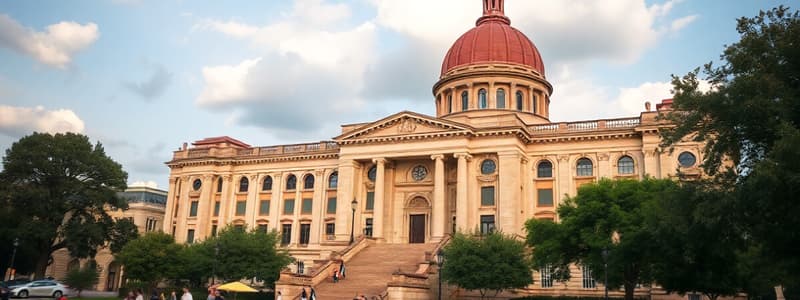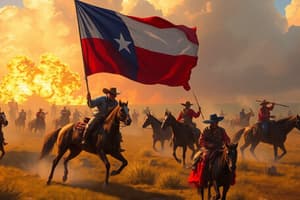Podcast
Questions and Answers
Match the following individuals with their roles during the Republic of Texas:
Match the following individuals with their roles during the Republic of Texas:
Sam Houston = First President of the Republic of Texas Mirabeau B. Lamar = Second President of the Republic of Texas Hardin R. Runnels = Candidate in gubernatorial elections against Sam Houston Stephen F. Austin = Considered the Father of Texas
Match the following events with their descriptions:
Match the following events with their descriptions:
Santa Fe Expedition = A failed military campaign into New Mexico Mier Expedition = An attempt to invade Mexico that led to capture Texas Troubles = A series of violent conflicts over slavery in Texas Annexation from Texas perspective = Desire for security and prosperity through statehood
Match the following political groups with their key characteristics during mid-century Texas:
Match the following political groups with their key characteristics during mid-century Texas:
Democrats = Favored states' rights and expansion Whigs = Strong advocates of federal government and internal improvements Know-nothings = Anti-immigrant and nativist political group Republicans = Emerging party opposing the expansion of slavery
Match the following political strategies with their descriptions:
Match the following political strategies with their descriptions:
Match the following aspects of society with their implications in mid-nineteenth century Texas:
Match the following aspects of society with their implications in mid-nineteenth century Texas:
What was a significant outcome of the Santa Fe Expedition during the Republic of Texas?
What was a significant outcome of the Santa Fe Expedition during the Republic of Texas?
Which factor was a key influence in Texas secession during the Civil War period?
Which factor was a key influence in Texas secession during the Civil War period?
How did the political landscape in mid-century Texas reflect national trends?
How did the political landscape in mid-century Texas reflect national trends?
Which best describes the focus of Lamar's presidency compared to Houston's during the Republic of Texas?
Which best describes the focus of Lamar's presidency compared to Houston's during the Republic of Texas?
What was an important political consequence of the gubernatorial elections of 1857 and 1859 in Texas?
What was an important political consequence of the gubernatorial elections of 1857 and 1859 in Texas?
Flashcards are hidden until you start studying
Study Notes
Government in Texas at time of Independence
- Texas declared independence from Mexico in 1836, forming a new republic.
- The government was modeled after the United States, featuring a President, a Congress, and a Supreme Court.
- The Constitution of the Republic of Texas aimed to protect individual liberties and uphold principles of self-governance.
Primary Culture in Texas at time of Independence
- Anglo-American settlers constituted the majority of Texas' population at the time of independence.
- Texan culture was heavily influenced by Southern agrarian values and traditions.
- The economy was primarily based on agriculture, particularly cotton production.
First President of Republic of Texas (Houston)
- Sam Houston served as the first president of the Republic of Texas from 1836 to 1838, and again from 1841 to 1844.
- He played a pivotal role in securing Texas independence and uniting the diverse population.
- Houston's presidency was marked by efforts to establish a stable government and foster relations with foreign powers.
Second President of Republic of Texas (Lamar)
- Mirabeau B. Lamar served as the second president of the Republic of Texas from 1838 to 1841.
- Unlike Houston, Lamar favored westward expansion and aggressive policies towards Mexico.
- His administration saw the establishment of Texas' first public education system and promotion of the arts.
Politics of Caution
- This refers to a political philosophy that advocated for cautious and conservative policies for Texas.
- It was associated with figures like Sam Houston, who prioritized stability and diplomacy.
- Supporters believed in gradual economic development and avoiding costly conflicts.
Politics of Action
- This refers to a more aggressive and ambitious political approach embraced by figures like Mirabeau B. Lamar.
- It emphasized westward expansion, military preparedness, and asserting Texas' claims over disputed territories.
- Supporters advocated for assertive action, seeking to position Texas as a powerful and influential entity.
Santa Fe Expedition
- In 1841, a Texan expedition under the leadership of General Hugh McLeod attempted to conquer Santa Fe, New Mexico, then under Mexican control.
- The expedition failed miserably, leading to the capture of most Texans and exacerbating tensions between Texas and Mexico.
Mier Expedition
- In 1842, another Texan expedition, led by William G. Cooke, aimed to recapture territory lost to Mexico.
- The expedition culminated in a bloody battle at Mier, ending with the capture of Texan troops and contributing to the escalating conflict with Mexico.
Annexation from Texas Perspective
- Texas sought annexation from the United States to gain stability, economic growth, and protection from Mexico.
- Concerns remained over the potential abolition of slavery and the impact on Texan sovereignty.
- After negotiating various terms, Texas ultimately voted in favor of annexation in 1845.
Annexation from United States Perspective
- The United States saw the annexation of Texas as an opportunity to expand its territory and secure control over the valuable land bordering Mexico.
- The annexation was strategically important for the expansion of slavery, and contributed to the escalating tensions that led to the Mexican-American War.
- The annexation was also a response to the rising power of Great Britain in the Americas.
Transportation in Mid-nineteenth century Texas
- The development of transportation infrastructure, including roads, waterways, and eventually railroads, played a significant role in Texas' economic growth.
- Roads and waterways facilitated trade and communication, connecting different regions and fostering economic activity.
- The arrival of railroads in the 1850s revolutionized transportation, accelerating the growth of cities and industries.
Texas Society at Mid-century
- The mid-century Texas society was characterized by a diverse population, consisting of Anglos, Mexicans, African Americans, and European immigrants.
- The economy remained primarily agrarian, with cotton production dominating the agricultural sector.
- Increasing urbanization led to the development of bustling cities like Houston, Galveston, and San Antonio.
Slavery in Texas
- Slavery was an integral part of Texas society, forming the foundation of the state's economy and social structure.
- The institution of slavery was fiercely defended by powerful landowners and politicians.
- Abolitionist movements gained traction in the North, leading to escalating tensions between North and South.
Mid-century Texas Politics
- The mid-century political scene in Texas was dominated by two major parties: the Democrats and the Whigs.
- The Democrats, generally aligned with Southern interests and supporting slavery, held a strong majority in the state.
- The Whigs, advocating for moderate federalism and opposing the expansion of slavery, remained a minority with some influence.
Democrats
- Generally represented the interests of Southern planters and agriculturalists.
- Supported the expansion of slavery and opposed federal interference in state matters.
- Dominated Texas politics during the mid-century, holding strong influence in both state and national government.
Whigs
- Advocated for economic development and social reform while opposing the expansion of slavery.
- Represented a more moderate, nationalistic viewpoint in contrast with the pro-slavery Democrats.
- Maintained some political influence, especially in urban centers and among industrialists.
Know-nothings
- This anti-immigrant, nativist political party gained some prominence in the 1850s.
- They advocated for restricting immigration and protecting the interests of native-born Americans.
- Their popularity peaked in the mid-50s before declining as the issue of slavery took center stage.
Republicans
- The newly formed Republican Party emerged in the late 1850s, opposed to the expansion of slavery.
- It gained traction in the North and became a major force in national politics.
- The Republican platform offered an alternative to the Democratic Party's pro-slavery stance.
Hardin R. Runnels vs. Sam Houston
- The 1857 gubernatorial election in Texas pitted incumbent Democrat Hardin R. Runnels against former President Sam Houston.
- Houston ran as an independent, advocating for reconciliation with the North and opposing secession.
- Runnels, supported by the pro-slavery Democratic Party, defeated Houston and continued to implement policies that supported Southern interests.
Gubernatorial Elections of 1857 & 1859
- The 1857 election saw Hardin R. Runnels win re-election against Sam Houston, solidifying the Democratic Party dominance in Texas politics.
- The 1859 election saw Sam Houston narrowly lose to the pro-secession Democrat, Hardin R. Runnels once again.
- These elections reflected the growing political polarization between those supporting secession and those opposing it.
Deciding factors for Texas Secession
- The election of Abraham Lincoln in 1860, fueled by rising tensions over slavery, became the catalyst for Texas secession.
- The South feared Lincoln's Republican Party's commitment to curtailing slavery.
- The belief that Texas' rights and interests were under threat led to the decision to secede from the Union.
Sam Houston's Response to Secession
- Sam Houston, a staunch Unionist, vehemently opposed Texas' secession.
- He believed that the South's decision was a grave mistake, ultimately leading to a devastating war.
- Houston was forced to resign as governor in 1861 after refusing to take an oath of allegiance to the Confederacy.
North Texas Counties in 1860
- North Texas counties in 1860 generally held a more moderate stance on secession than those in the southern part of the state.
- Some counties had a higher proportion of Unionists, evidenced by their later resistance to Confederate authority.
- Regional differences in attitudes towards secession mirrored the broader divisions within Texas society.
"Texas Troubles"
- This refers to the series of challenges and conflicts that plagued Texas during the Civil War era.
- These included internal divisions over secession, military campaigns in Texas, and the impact of federal occupation after the war.
- "Texas Troubles" represents a critical era in Texas history, shaped by both the larger national conflict and its own internal struggles.
Government in Texas at time of Independence
- Texas adopted a constitution with a unicameral legislature and a president as chief executive.
- This system was influenced by the US Constitution and aimed for a strong central government.
Primary culture in Texas at time of Independence
- Anglo-American settlers dominated Texas society, bringing their cultural practices and values.
- This included a frontier spirit, individualistic ideals, and strong religious beliefs.
First President of Republic of Texas (Houston)
- Sam Houston served as the first president of the Republic of Texas from 1836 to 1838.
- He implemented policies focused on peace and stability, prioritizing diplomatic relations with the United States.
Second President of Republic of Texas (Lamar)
- Mirabeau B. Lamar, Houston's successor, pursued a more aggressive and expansionist policy.
- He aimed at westward expansion and clashed with Mexico, leaving the Republic in a state of conflict.
Politics of Caution
- This political ideology championed peace and stability in Texas.
- Emphasized diplomacy, careful expansion, and maintaining friendly relations with the United States.
Politics of Action
- This ideology favored an aggressive stance, pushing for westward expansion and asserting Texas's independence.
- Advocated for military strength and confrontation with Mexico.
Santa Fe Expedition
- A military venture led by Texas in 1841, aiming to claim New Mexico for the Republic.
- It ended in failure due to inadequate preparations and Mexican resistance.
Mier Expedition
- A Texas military campaign in 1842, resulting in the capture of Texan soldiers by Mexican forces.
- Led to the "Mier prisoners" incident, where prisoners of war were faced with the "black bean" lottery, determining their fate.
Annexation from Texas Perspective
- Texas sought annexation to the United States for economic and political reasons
- It offered stability, protection from Mexico, and potential for increased trade and development after facing financial struggles as an independent nation.
Annexation from United States Perspective
- The United States had a complex perspective on Texas annexation.
- The expansionist ideology sought to secure control over the territories and secure a potential slave-holding state, but political debates regarding slavery and Mexico's reaction impacted the decision.
Transportation in Mid-nineteenth Century Texas
- The Texas economy heavily relied on limited transportation networks, particularly river transportation.
- This posed a significant obstacle to commerce and communication due to the lack of established roads and railroads.
Texas society at mid-century
- Texas society during this period was diverse, including Anglo-American settlers, Mexican Texans, African Americans, and Native American communities.
- Economic development was slow, mainly driven by agriculture, ranching, and trade.
Slavery in Texas
- Slavery was a central issue in Texas throughout the mid-nineteenth century.
- It underpinned the economy, particularly in agriculture and cotton production.
Mid-century Texas Politics
- The political landscape of Texas changed in the 1850s, reflecting national political trends and the rising tide of sectionalism.
Democrats
- Democrats were primarily associated with Southern interests, supporting expansion, limited government, and the protection of slavery.
- They appealed to voters concerned with states' rights and agrarian principles.
Whigs
- Whigs were more aligned with Northern interests, advocating for economic development, a stronger federal government, and limited expansion.
- They appealed to voters seeking economic growth and greater national control.
Know-Nothings
- This nativist movement arose in reaction to the growing number of immigrants, mainly from Ireland and Germany.
- Opposed the growing influence of Catholic immigrants, advocating for restrictions on immigration and promoting Protestant values.
Republicans
- The Republican Party emerged in the mid-1850s as a force opposing the expansion of slavery.
- This party sought to prevent the spread of slavery into Western territories, leading to growing tensions with Southern states.
Hardin R. Runnels vs. Sam Houston
- This 1857 gubernatorial election saw a conflict between two prominent figures in Texas politics.
- Hardin R. Runnels, a pro-slavery Democrat, won the election against Sam Houston, who opposed the expansion of slavery and had criticized secession. This marked a shift in favor of those supporting slavery and secession in Texas politics.
Gubernatorial elections of 1857 & 1859
- The elections of 1857 and 1859 were crucial in shaping the political landscape of Texas, reflecting the growing divide between pro-slavery and anti-slavery factions.
- These elections foreshadowed the growing tension and the eventual secession of Texas from the Union.
Deciding factors for Texas secession
- The rising tension between Northern and Southern states over slavery was a key factor influencing Texas's decision to secede.
- The election of Abraham Lincoln, a candidate opposed to slavery, was seen as a threat to Southern rights and economic interests, prompting Texas to join the Confederate States of America.
Sam Houston's response to secession
- Sam Houston, a staunch Unionist and opposed to secession, opposed Texas joining the Confederacy.
- He lost his position as Governor of Texas due to his opposition to secession.
North Texas Counties in 1860
- North Texas counties experienced a shift in political ideology and identity due to their economic ties and migration patterns.
- This led to a greater influence of Northern ideals and a reluctance to join the Confederacy, reflecting a divergence from the more pro-secession Southern sentiment.
"Texas Troubles"
- This term refers to the period of unrest and violence in Texas during and after the Civil War, marked by battles, guerrilla warfare, and political turmoil.
- It stemmed from the conflict between Confederate and Union forces, leading to a turbulent period of reconstruction and readjustment for Texas society.
Studying That Suits You
Use AI to generate personalized quizzes and flashcards to suit your learning preferences.




